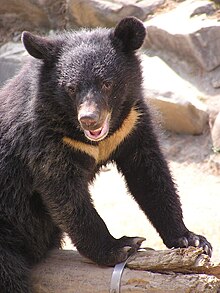Our website is made possible by displaying online advertisements to our visitors.
Please consider supporting us by disabling your ad blocker.
Formosan black bear
| Formosan black bear | |
|---|---|

| |
| Scientific classification | |
| Domain: | Eukaryota |
| Kingdom: | Animalia |
| Phylum: | Chordata |
| Class: | Mammalia |
| Order: | Carnivora |
| Family: | Ursidae |
| Genus: | Ursus |
| Species: | |
| Subspecies: | U. t. formosanus
|
| Trinomial name | |
| Ursus thibetanus formosanus R. Swinhoe, 1864[2]
| |
| Synonyms | |
| |
The Formosan Black Bear (Chinese: 臺灣黑熊, Ursus thibetanus formosanus), also known as the Taiwanese black bear or white-throated bear, is a subspecies of the Asiatic black bear. It was first described by Robert Swinhoe in 1864. Formosan black bears are endemic to Taiwan. They are also the largest land animals and the only native bears (Ursidae) in Taiwan. They are seen to represent the Taiwanese nation.
Because of severe exploitation and habitat degradation in recent decades, populations of wild Formosan black bears have been declining. This species was listed as "endangered" under Taiwan's Wildlife Conservation Act (野生動物保育法) in 1989. Their geographic distribution is restricted to remote, rugged areas at elevations of 1,000–3,500 m (3,300–11,500 ft). The estimated number of individuals is 200 to 600.[3]
- ^ a b Garshelis, D. & Steinmetz, R. (2020). "Ursus Thibetanus". IUCN Red List of Threatened Species. 2020: e.T22824A166528664. doi:10.2305/IUCN.UK.2020-3.RLTS.T22824A166528664.en. Retrieved 16 January 2022.
- ^ Swinhoe, R. (1864). "Extracts from letters from, addressed to Dr.J. E. Gray". Proceedings of the Zoological Society of London. 32: 380. doi:10.1111/j.1469-7998.1864.tb00409.x.
- ^ 何宜 (2014-03-13). "黃美秀與台灣黑熊 愛的三部曲". 台灣動物新聞網. Archived from the original on 2020-02-02. Retrieved 2019-03-17.
Previous Page Next Page



